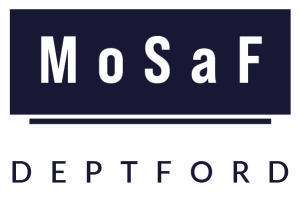The triangular, or transatlantic, slave trade spanned three centuries and saw a vast number of enslaved people transported across the Atlantic. Last month, in this three-part series, we covered what the triangular slave trade was and how it started. This month we ask: what were the key events and how does this link to Deptford’s history?
The Deptford Shipyard
Deptford’s connection to the trade in enslaved African people starts with the ships built in its dockyard. John Hawkins (1532-1595) was an admiral in Elizabeth I’s Navy. He was the first English trader in enslaved people to operate in the triangular trade. He lived and worked in Deptford, but he made his profits from the labour of enslaved people on the other side of the world. His financial success was followed by investors in the nearby financial heart of London who, chasing slaving profits, established a thriving shipbuilding industry in Deptford. From its royal dockyard, naval ships were used to convoy slave ships and to protect the Caribbean plantation economy system.
The Companies
The South Sea Company was formed in 1711 to supply enslaved people to Spanish America. Investors hoped that financial returns would be substantial and support for the company grew until the bubble of speculative financing burst in 1720. It’s testament to the central role that vast amounts of money (often far from Africa or the Americas) played in the slave trade.
But the South Sea Company was not the first company established to formalise financial gain from the sale of enslaved people. For example, back in 1672, The Royal African Company was formed to regulate the English slave trade by offering a legal monopoly over a vast stretch of West African coastline. The triangular slave trade was driven by money over morality from the very beginning.
The Trading Forts
Money, goods and people were traded across the triangular lines of the transatlantic slave trade from the 16th century, but the pattern intensified in the 17th and 18th centuries. This expansion increased the need for more and more resources which meant capturing and transporting more people into slavery. Permanent trading camps or forts were established on West African shores to do this. Here people considered ‘fit’ by a surgeon were branded and held until they could be sold to passing slave ships, like those that left the shores of Deptford.
The Zong Massacre
The Zong Massacre was a horrendous act against enslaved people and a monumental case in legal history. More than 130 Africans were thrown overboard from the Zong, a slave ship, as it travelled across the Atlantic in 1781. It would later be claimed that the crew and enslaved captives were facing a shortage of water. It may be, however, that the murders were financially driven.
The case reached the English courts when the ship owners attempted to claim compensation from their insurers for commercial loss. To many, this highlighted the attitude towards the lives of enslaved people, that their worth was purely financial. Reactions to this brutal act, and the subsequent court case, advanced the progression of the abolitionist movement.
For more detail, listen to the In Our Time discussion episode about the Zong Massacre here.
The Fight for Freedom
From quiet subversions to slave ship mutinies, there were many forms of resistance whilst the triangular slave trade existed. There was endless potential for uprisings. Here are some notable conflicts:
- 1760: Known as Tacky’s Revolt after the leader Tacky (Akan spelling: Takyi), this revolt by enslaved people in Jamaica was one of the largest in a British Colony during the 18th century
- 1791: Toussaint Louverture led the fight for freedom on the French-controlled island of St Domingue (later Haiti)
- 1795: Fédon’s revolt, led by Julien Fédon, in Grenada
- 1804: After a series of conflicts, Haiti was established as an independent state, the first free Black republic
In the 19th century, the campaign for liberty intensified. Slavery may have been abolished in 1807, but formerly enslaved people were still subject to exploitation. Many worked on the same plantations for the same families who had enslaved them in the recent past.
Next month, we’ll explore the abolition of the triangular slave trade, how Olaudah Equiano took up the fight against slavery and the connections to Deptford’s story.
As ever, if you’re interested in learning more about our campaign to build a Museum of Slavery and Freedom in Deptford, keep an eye on our ‘What’s On’ tab – and sign up to our quarterly emails here.
Further Reading List From Dr. Helen Paul
- G. Davies, The Royal African Company
- James Walvin, The Zong: A Massacre, the Law and the End of Slavery
- Sudhir Hazareesingh, Black Spartacus: The Epic Life of Toussaint Louverture
- Robin Law, The Slave Coast of West Africa
- Harry Kelsey, Sir John Hawkins: Queen Elizabeth’s Slave Trader

One Response